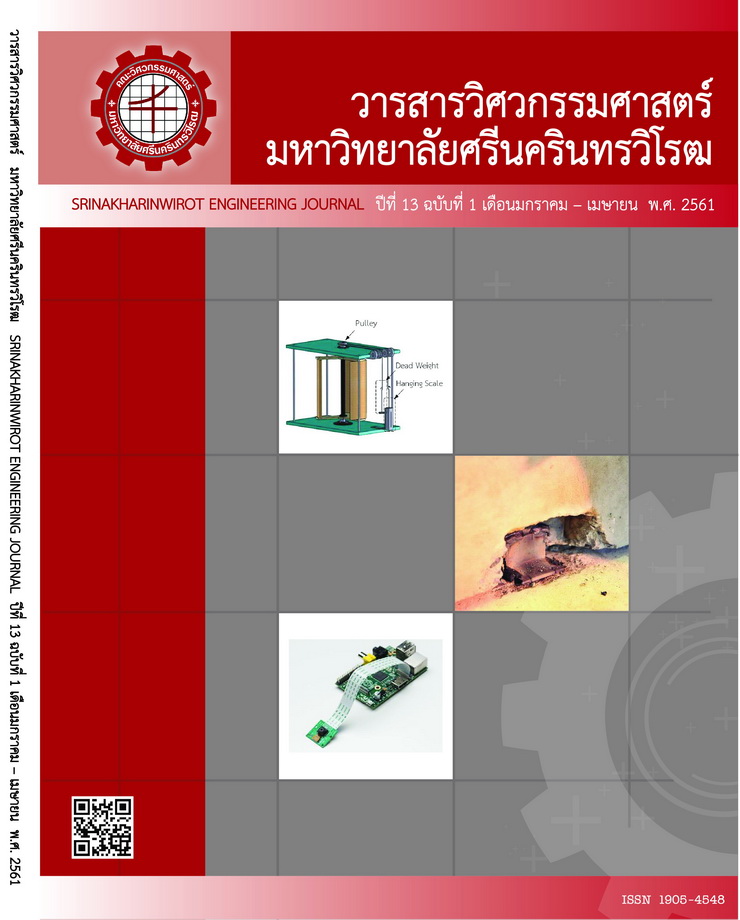Basic Properties and Carbonation of Concrete Replaced with Different Binders
Main Article Content
Abstract
This study was aimed to study the basic properties and the carbonation depth of partially replaced concrete with fly ash, granulated blast-furnace slag (GGBS) and limestone powder in ordinary Portland cement (OPC). The results showed that the water requirement of paste with fly ash was lesser than that of OPC paste. While the water requirement of paste made with GGBS and limestone powder was higher when compared to that of OPC paste. Additionally, the setting time of paste with fly ash and paste with GGBS was higher than that of OPC paste, while paste with limestone powder was lesser when compared to that of OPC paste. Moreover, the slump of concrete with fly ash was higher than that of OPC concrete whereas the slump of concrete with GGBS and limestone powder was lesser when compared to that of OPC concrete. The compressive strength of concrete with fly ash and GGBS was less than that of OPC concrete, especially when replaced in large quantity. Also, the compressive strength of concrete with limestone powder was close to that of OPC concrete. The carbonation depth of concrete with fly ash and GGBS was significantly higher than that of OPC concrete. The carbonation depth of concrete mixed with limestone powder was close to or little higher when compared to that of OPC concrete. The carbonation depth of concrete in water curing condition was lesser than that of concrete in air curing condition. The longer carbon dioxide exposure of concrete resulted in a greater carbonation depth than that of concrete with shorter carbon dioxide exposure. Finally, it can be compared the basic properties and the carbonation depth of concrete with fly ash, GGBS and limestone powder with OPC concrete.
Article Details
Copyright belongs to Srinakharinwirot University Engineering Journal
References
[2] S. K. Roy, K. B. Poh and D. O. Northwood, “Durability of concrete accelerated carbonation and weathering studies,” Building. Env., vol. 34, pp. 597-606, August 1998.
[3] J. Khunthongkeaw, S. Tangtermsirikul, and T. Leelawat, “A study on carbonation depth prediction for fly ash concrete,” Construc. Building Mater., vol. 20, pp. 744-753, January 2006.
[4] C. D. Atis, “Accelerated carbonation and testing of concrete made with fly ash,” Construc. Building Mater., vol. 17, pp. 47–152, October 2003.
[5] N. I. Fattuhi, “Carbonation of concrete as affected by mix constituents and initial water curing period,” Materiaux et Constructions, vol. 19, no.110, pp. 131-136, 1986.
[6] กฤษฎา เสือเอี่ยม และณัฏฐ์ มากุล, “อิทธิพลของฝุ่นหินปูนต่อสมบัติของซีเมนต์เพสต์ชนิดไหลตัวได้ผสมเถ้าแกลบ,” วิศวกรรมสารฉบับวิจัยและพัฒนาม ปีที่ 23, ฉบับที่ 3, หน้า 65-73, 2555.
[7] ปิยะพงศ์ กี่สวัสดิ์คอน, รัฐศักดิ์ พรหมมาศ และ ทวีศักดิ์ รุ่งศักดิ์ทวีกุล, “อัตราการซึมผ่านน้ำในคอนกรีตผสมเถ้าทลายปาล์มน้ำมันและหินฝุ่นแทนทรายที่บ่มด้วยคลื่นไมโครเวฟ,” รายงานการวิจัย มหาวิทยาลัยเทคโนโลยีราชมงคลรัตนโกสินทร์, 2558.
[8] อภิชิต คำภาหล้า, โกสีห์ เทียมลม และจิระยุทธ สืบสุข, “อิทธิพลของวิธีการบ่มต่อการพัฒนากำลังรับแรงอัดของคอนกรีต,”วารสารวิจัย มหาวิทยาลัยเทคโนโลยราชมงคลตะวันออก ปีที่ 7, ฉบับที่ 2, หน้า 87-96, 2557.
[9] Standard Test Method for Fineness of Hydraulic Cement by Air-Permeability Apparatus, ASTM C 204 – 00, 2000.
[10] Standard Test Method for Density of Hydraulic Cement, ASTM C 188 – 95, 1995.
[11 Standard Test Method for Amount of Water Required for Normal Consistency of Hydraulic Cement Paste, ASTM C 187 – 11, 2011.
[12] Standard Test Method for Time of Setting of Hydraulic Cement by Vicat Needle, ASTM C 191 – 13, 2013.
[13] Standard Test Method for Slump of Hydraulic-Cement Concrete, ASTM C 143/C 143M – 98, 1998.
[14] Method of Making Test Cube from Fresh Concrete, British Standard Institute, BS 1881: Part 108, 1983.
[15] Standard Test Method for Compressive Strength of Hydraulic Cement Mortars (Using 2-in. or [50-mm] Cube Specimens)1, ASTM C 109 – 07, 2007.
[16] Standard Practice for Petrographic Examination of Hardened Concrete, ASTM C 856 – 04, 2004.


